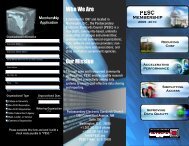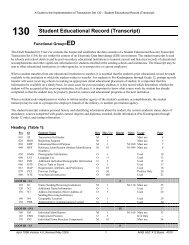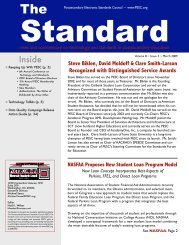February 2013 - PESC
February 2013 - PESC
February 2013 - PESC
You also want an ePaper? Increase the reach of your titles
YUMPU automatically turns print PDFs into web optimized ePapers that Google loves.
2012 Survey of Chief Information Officers 19<br />
over using cloud computing. Most public and private<br />
institutions were more interested in saving money.<br />
Security, privacy concerns, ownership protection, and<br />
access to data are also very important to most CIOs.<br />
Cloud Computing Impact on Budget<br />
Most institutions reported expectations for a moderately<br />
positive impact on the budget when using cloud<br />
computing; however, 68% of research institutions expect<br />
moderately positive to very positive results utilizing cloud<br />
computing. Interestingly, doctoral-granting institutions<br />
expect higher negative impact than others (11.1%),<br />
even though the majority of doctoral-granting institutions<br />
expect positive or very positive impact (46% and 9.5%,<br />
respectively). Two-year institutions expect some negative<br />
impact (somewhat negative, 9.5%; and very negative,<br />
4.8%) and the lowest overall moderately or very positive<br />
impact (only 47.7% total).<br />
Cloud- computing Activities<br />
Not sure<br />
Mix of academic and administrative and community<br />
55.3%<br />
Community service or outreach<br />
Mostly management needs (administrative information)<br />
20.1% 3.6%<br />
Mostly academic (teaching and learning)<br />
3.8%<br />
1.3%<br />
19.5%<br />
Applications in the cloud<br />
Most institutions are cautiously moving ahead in<br />
implementing cloud applications on campus. Mail is<br />
the primary application that all institutions, regardless<br />
of size, type, and classification, have moved to the<br />
cloud. This is not surprising because vendors have<br />
supplied and created e-mail applications for the general<br />
population, which increased both interest and personal<br />
use of e-mail. Vendors have also assisted in moving<br />
the on-campus service to the cloud at no cost to the<br />
institution, which eased many IT budgets. The second<br />
leading application reported in the cloud is social<br />
networking; again, the application existed in the cloud,<br />
and the user community encouraged the adoption of<br />
the application as a campus service. It is noteworthy<br />
that most CIOs do not consider campus enterprise<br />
applications (e.g., ERP, CMS, library systems) as good<br />
candidates to move to the cloud.<br />
Applications Currently in the Cloud<br />
Other (please specify) 23.5%<br />
Student applications<br />
(enrollment management)<br />
19.6%<br />
Financial applications 6.1%<br />
Library applications 27.9%<br />
Desktop tools (i.e. MS Office) 26.3%<br />
Data center 12.3%<br />
Portal 13.4%<br />
Social Networking 43.6%<br />
E-Mail 83.2%<br />
Applications expected to move to the cloud<br />
All institutions are planning to move similar applications<br />
to the cloud. The primary growth will be experienced<br />
in moving mail/social applications and learningmanagement<br />
systems to the cloud. More than 80% of<br />
two-year institutions are planning to move the learningmanagement<br />
system to the cloud, compared with 50%<br />
of all other institutions. Many new learning-management<br />
systems are offered only as a cloud application, which<br />
encourages institutions to consider the migration. One<br />
interesting service being considered for cloud adoption<br />
is storage, with more than 50% of all institutions<br />
considering storage in the cloud.
















